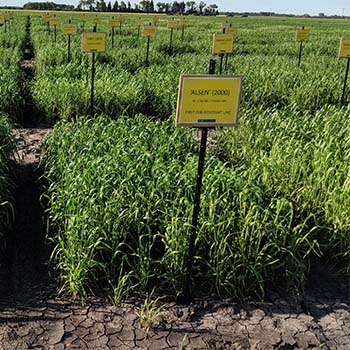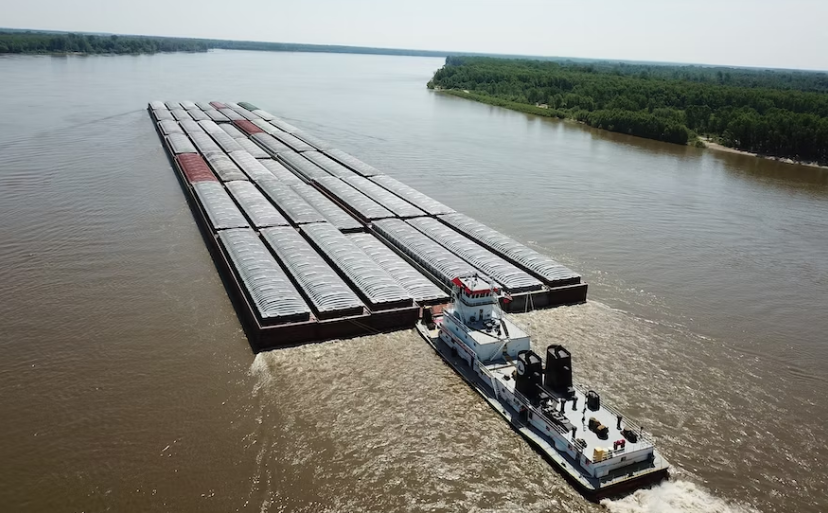Editor’s Note: Following are excerpts from the “Wheat Scoop” blog from U.S. Wheat Associates state commission member Kansas Wheat. Read the full article here. Photo above Copyright Kansas State University.
Long, long ago in a land far, far away, bread wheat came into existence. Researchers are still unlocking the secrets of the wild relatives of that ancient wheat to improve modern-day varieties – and a collection of seeds housed on Kimball Avenue in Manhattan [Kansas] is key to this work.

Bikram Gill – Photo Copyright Kansas State University.
Bikram Gill and John Raupp with [Kansas State University’s] Wheat Genetics Resource Center sat down with Aaron Harries, Kansas Wheat vice president of research and operations … to share wheat’s origin story and how the collection continues to provide valuable genetic resources for modern wheat breeding programs.
Evolutionary Events
To understand this potential, one must go way back to the origin of wheat as a species in the Fertile Crescent – where the crop helped start human civilization more than 10,000 years ago. At that time, wheat did not yet exist. It would take two major evolutionary events that mixed three different grass species to make the first bread wheat genome.
The first stop on this timeline was the merger of two wild ancestors that resulted in the eventual creation of wild emmer wheat (genome formula AB).
“As a species in nature, nature produced bread wheat around half a million years ago,” Gill said. “Two grasses, they happened to have fun. They hybridized – and that produced bread wheat.”
The second stop on the timeline came … when that wild emmer wheat was combined with an ancient goatgrass (genome formula D). That genetic mix resulted in the first crop cultivated by humankind.
“In some farmer’s field, some goat grass hybridized with emmer wheat, which originated in Syria,” Gill said. “And that farmer was smart enough, he selected that plant. And that’s our bread wheat.”
From there, Mother Nature kept mixing in wild wheat relatives to this new bread wheat – and farmers selected the most successful versions to plant again.
“After wheat originated, these wild wheats kept cross-hybridizing with domesticated wheat,” Gill said. “There were no breeders, but nature was doing breeding for the first 10,000 years. They were cross-pollinating and farmers were selecting new types out of that.”
A Complex Genome
This origin story from Kansas State scientists is important because it explains why the wheat genome is so complex. Wheat is a hexaploid, meaning it has six sets of seven chromosomes. Most genes in wheat exist in three copies – one each from those A, B and D genomes. As a result, there are 16 billion DNA letters in the wheat genome – the human genome has three billion letters – meaning you could type out the genetic code of wheat in 12-point font and the type will go around the world.
This triplication and redundancy make wheat very hard to genetically analyze.
“It’s essentially three different genomes coexisting in one,” Gill said. “Wheat is a very elegant genetic system.”
While hard to pick through, that complexity also makes wheat a more durable crop.
“This is called genetic buffering,” Gill said. “Wheat can tolerate the extremes of environment because of this buffering caused by the redundancy of the genes.”
With this understanding of the origin and complexity of wheat, how does that relate to wheat breeding programs? Fast forward to 1979 when Gill did a postdoctoral fellowship at Kansas State and was first exposed to the genetic stocks used to map genes and breed wheat. He took that experience with him to his second postdoctoral fellowship at the University of California-Riverside, where he was blown away by the genetic diversity of a collection of wild weeds.
Gill started to form a vision of a resource that would combine the two – a collection of wild wheat relatives with unlocked genetic potential and a wheat breeding program that could replicate Mother Nature’s process of pulling in traits to make better varieties for farmers to plant.
In 1980, Gill wrote a grant and flew on a small plane to Hutchinson, the then-headquarters of the Kansas Wheat Commission to pitch his idea.
“I presented my vision – we want to establish the Wheat Genetics Resource Center … A yield bump is going to come from this because of that genetic diversity. Nobody knew what wild wheats were in the Great Plains at that time. I said I know that this is where the next big evolution is.”
Backed by approval from Kansas State’s wheat breeder at the time, the commissioners agreed to provide the seed money. Gill gathered an initial collection of 500 genetic lines, including seeds from collections in Japan, Israel, Russia and other countries. He immediately dove into early projects identifying Hessian fly resistance and leaf rust resistance …
“We are just doing what happened in nature,” Gill said. “That’s how bread wheat arose, so we are essentially repeating the same process except we’re doing it in the lab.”

Since 1980, John Raupp has served as curator of the Kansas State Wheat Genetics Resource Center a collection is up to about 4,200 genetic lines used by wheat breeders locally and around the world.
International Cooperation
Raupp has served as the curator of the Wheat Genetics Resource Center since August 1980. He noted the collection is up to about 4,200 lines …It’s his job to maintain the stocks of this genetic material, making sure scientists and breeders have access to the seeds they need to complete projects … To maintain their integrity, the seeds must be planted, grown either in a greenhouse or an outdoor plot and often hand-harvested to replenish seeds before they are no longer viable.
Today, Raupp noted he annually fulfills about 100 different requests for those seeds from researchers in neighboring states to those in countries on the other side of the planet. Aided by modern research techniques like genetic sequencing and CRISPR, these researchers continue to unlock more of that ancient genetic potential to improve the wheat varieties of tomorrow.
“It’s been a gold mine,” Harries said. “You go treasure hunting in this collection that you’ve created here. A lot of the traits that we have for stripe rust, leaf rust and viral traits all come from those wild wheat relatives. And that work is far from over.”
Learn more about wheat’s origin story and the Kansas State Wheat Genetics Resource Center by listening to the full “Wheat’s on Your Mind” podcast episode at www.WheatsOnYourMind.com. Watch the video below to learn more about how wheat breeders use genetic lines to produce new, more productive, higher quality U.S. wheat varieties.
By Julia Debes for Kansas Wheat








 Illinois produces more soft red winter (SRW) than any other U.S. state. Members of the Illinois Wheat Association (IWA) are now circulating petitions to institute a wheat checkoff in the state, Brownfield News reports. Checkoffs approved by farmers and operated under state statutes establish wheat commissions that manage funds collected when wheat is first sold. Don Guinnip, with IWA, who farms in Marshall & Clark County, told Brownfield, “We need to be promoting wheat.” The petitions lead to a hearing with the state ag department and, IWA hopes, to a farmer referendum in 2025. Funding from 17 state wheat commission members of USW allows the organization to apply for export market development program funding. Read more
Illinois produces more soft red winter (SRW) than any other U.S. state. Members of the Illinois Wheat Association (IWA) are now circulating petitions to institute a wheat checkoff in the state, Brownfield News reports. Checkoffs approved by farmers and operated under state statutes establish wheat commissions that manage funds collected when wheat is first sold. Don Guinnip, with IWA, who farms in Marshall & Clark County, told Brownfield, “We need to be promoting wheat.” The petitions lead to a hearing with the state ag department and, IWA hopes, to a farmer referendum in 2025. Funding from 17 state wheat commission members of USW allows the organization to apply for export market development program funding. Read more 













